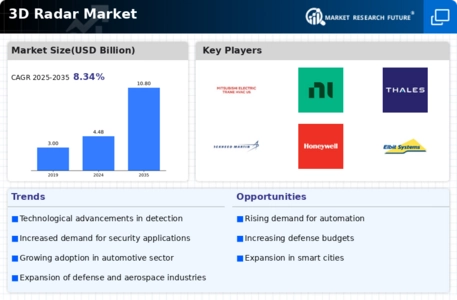Market Analysis
3D Radar Market (Global, 2023)
Introduction
The 3D Radar Market is experiencing a transformative phase, driven by advancements in radar technology and an increasing demand for enhanced surveillance and detection capabilities across various sectors. This innovative technology, which provides three-dimensional imaging and tracking, is becoming indispensable in applications ranging from defense and aerospace to automotive and environmental monitoring. As industries seek to improve operational efficiency and safety, the integration of 3D radar systems is gaining traction, offering superior accuracy and reliability compared to traditional radar solutions. Furthermore, the growing emphasis on automation and smart technologies is propelling the adoption of 3D radar systems, as they play a crucial role in enabling autonomous vehicles and smart city infrastructure. The market landscape is characterized by a diverse range of players, including established manufacturers and emerging startups, all vying to capitalize on the opportunities presented by this dynamic field. As the technology continues to evolve, stakeholders are increasingly focused on innovation, strategic partnerships, and the development of tailored solutions to meet the specific needs of various industries.
PESTLE Analysis
- Political
- In 2023, the political landscape surrounding the 3D radar market is heavily influenced by defense spending policies in various countries. For instance, the U.S. Department of Defense allocated approximately $800 billion for defense expenditures, which includes investments in advanced radar technologies. Additionally, international collaborations, such as NATO's focus on enhancing surveillance capabilities, have led to increased demand for 3D radar systems among member countries, with a reported increase of 15% in joint defense projects involving radar technologies.
- Economic
- The economic environment for the 3D radar market is shaped by the overall growth in the aerospace and defense sectors. In 2023, the global aerospace industry is projected to generate revenues of around $800 billion, with a notable portion directed towards advanced radar systems. Furthermore, the increasing adoption of 3D radar technology in commercial applications, such as automotive and maritime sectors, is expected to contribute to a market expansion, with estimates indicating that the automotive sector alone is investing over $10 billion in radar technologies for autonomous vehicles.
- Social
- Social factors impacting the 3D radar market include the rising public awareness of safety and security issues, particularly in urban environments. In 2023, surveys indicate that approximately 70% of consumers prioritize safety features in vehicles, driving demand for advanced radar systems in automotive applications. Additionally, the growing concern for environmental monitoring and disaster management has led to increased interest in 3D radar technologies for applications in weather forecasting and climate change studies, with funding for such initiatives reaching $500 million in various government programs.
- Technological
- Technological advancements are a key driver in the 3D radar market, with innovations in signal processing and data analytics enhancing the capabilities of radar systems. In 2023, the integration of artificial intelligence (AI) in radar technology has seen investments exceeding $2 billion, aimed at improving target detection and tracking accuracy. Moreover, the development of solid-state radar systems is gaining traction, with manufacturers reporting a 25% increase in production capacity to meet the growing demand for compact and efficient radar solutions.
- Legal
- Legal factors affecting the 3D radar market include stringent regulations regarding the use of radar technology in various applications. In 2023, the Federal Aviation Administration (FAA) implemented new guidelines for the use of radar systems in commercial aviation, requiring compliance with updated safety standards. Additionally, export control regulations on advanced radar technologies have tightened, with the Bureau of Industry and Security (BIS) reporting a 30% increase in licensing applications for radar exports, reflecting the need for compliance with international trade laws.
- Environmental
- Environmental considerations are increasingly relevant in the 3D radar market, particularly concerning the impact of radar systems on wildlife and ecosystems. In 2023, studies indicate that approximately 40% of radar installations in sensitive areas are subject to environmental assessments to mitigate potential disruptions to wildlife. Furthermore, the push for sustainable technologies has led to investments of around $300 million in developing eco-friendly radar systems that minimize energy consumption and reduce carbon footprints, aligning with global sustainability goals.
Porter's Five Forces
- Threat of New Entrants
- Medium - The 3D Radar Market has moderate barriers to entry due to the high level of technological expertise required and significant capital investment needed for research and development. However, advancements in technology and increasing demand for 3D radar systems may attract new players, leading to a moderate threat level.
- Bargaining Power of Suppliers
- Low - The bargaining power of suppliers in the 3D Radar Market is relatively low as there are numerous suppliers of raw materials and components. The availability of alternative suppliers and the ability of companies to switch suppliers without significant costs contribute to this low power.
- Bargaining Power of Buyers
- High - Buyers in the 3D Radar Market have high bargaining power due to the presence of multiple options and the ability to compare products. As customers become more informed and demand customized solutions, they can negotiate better terms, leading to increased pressure on manufacturers.
- Threat of Substitutes
- Medium - The threat of substitutes in the 3D Radar Market is moderate, as there are alternative technologies such as traditional radar systems and other sensing technologies. However, the unique advantages offered by 3D radar systems, such as enhanced accuracy and resolution, mitigate this threat to some extent.
- Competitive Rivalry
- High - Competitive rivalry in the 3D Radar Market is high, driven by the presence of several established players and the rapid pace of technological advancements. Companies are constantly innovating and improving their offerings, leading to intense competition for market share and customer loyalty.
SWOT Analysis
Strengths
- Advanced detection capabilities for various applications including defense and security.
- High accuracy and reliability in tracking moving objects.
- Growing demand in automotive and aerospace sectors for enhanced safety features.
- Technological advancements leading to miniaturization and cost reduction.
Weaknesses
- High initial investment and operational costs for implementation.
- Limited awareness and understanding of 3D radar technology among potential users.
- Complexity in integration with existing systems and infrastructure.
- Potential regulatory hurdles in certain regions affecting deployment.
Opportunities
- Increasing investments in defense and security sectors globally.
- Rising demand for autonomous vehicles and smart transportation systems.
- Expansion into emerging markets with growing infrastructure needs.
- Potential for innovation in consumer electronics and IoT applications.
Threats
- Intense competition from alternative technologies such as LiDAR and traditional radar.
- Rapid technological changes leading to obsolescence of current products.
- Economic downturns affecting government and private sector budgets.
- Cybersecurity threats that could compromise radar systems.
Summary
The 3D Radar Market in 2023 is characterized by its advanced detection capabilities and growing demand across various sectors, particularly in defense and automotive. However, the market faces challenges such as high costs and integration complexities. Opportunities for growth exist in emerging markets and the rise of autonomous technologies, while threats from competition and economic fluctuations could impact market stability. Strategic focus on innovation and education will be crucial for leveraging strengths and mitigating weaknesses.

















Leave a Comment